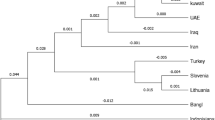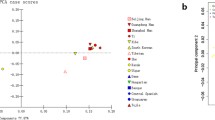Summary
BamHI polymorphism at the VNTR locus D2S44 was investigated, concentrating on band frequencies, mutation rate and confirmation of Mendelian inheritance. In this series 39 restriction fragments showing frequencies less than 10% could clearly be distinguished. No mutations could be observed and the Mendelian character of inheritance is beyond reasonable doubt.
Zusammenfassung
Der locus-spezifische BamH1/YNH24-DNA-Polymorphismus wurde in einer westdeutschen Stichprobe (n = 122) untersucht mit dem Ziel, Daten über die Fragmenthäufigkeiten, Mutationsraten und Vererbungsweisen zu erhalten. 39 Restriktionsfragmente konnten zweifelsfrei voneinander unterschieden werden. Keines der Fragmente erreichte eine Häufigkeit von mehr als 10%. Die Restriktionsfragmente werden der autosomal kodominanten Vererbungsweise entsprechend vererbt. Hinweise auf eine Mutation liegen nicht vor.
Similar content being viewed by others
References
Baird M, Balazs I, Giusti A; Miyazaki L, Nicholas L, Wexler K, Kanter E, Glassberg J, Allen F, Rubinstein P, Sussmann L (1986) Allele frequency distribution of two highly polymorphic DNA sequences in three ethnic groups and its application to the determination of paternity. Am J Hum Genet 39:489–501
Balazs I, Baird M, Clyne M, Meade E (1989) Human population genetic studies of five hypervariable DNA loci. Am J Hum Genet 44:182–190
Dykes DD (1987) Parentage testing using restriction fragment length polymorphisms (RFLPs). In: Lasky LC, Edwards-Moulds JM (eds) Clinical application of genetic engineering. AABB, Arlington, pp 59–85
Dykes DD (1988) The use of biotinylated DNA probes in parentage, testing: non-isotopic labeling and non-toxic extraction. Electrophoresis 9:359–368
Eede PP van, Henke L, Henke J, Lange GG de (1990) Size calculation of fragments detected by probe YNH24 and restriction enzyme HaeIII by comparison between two laboratories: the generation of fragment size frequencies. Forensic Sci Int (in press)
Fowler SJ, Gill P, Werrett DJ, Higgs OR (1988) Individual specific DNA fingerprints from a hypervariable region probe: alpha-globin 3′ HVR. Hum Genet 79:142–146
Harumoto T, Suzuki K, Matsui K, Ito S, Matsuo Y, Miyazaki T, Matsumoto H (1988) Allelic frequency of polymorphic sequences in Japanese and its application to the paternity testing. In: Mayr W (ed) Advances in forensic haemogenetics, vol 2. Springer, Berlin Heidelberg New York, pp 373–376
Helminen P, Ehnholm C, Lokki M-L, Jeffreys AJ, Peltonen L (1988) Application of DNA “fingerprints” to paternity determinations. Lancet 1:574–576
Henke J, Henke L (1988) ‘DNA-Fingerprinting’ — Anwendung der Gentechnik in der forensischen Hämogenetik. BTF-Biotech Forum 5:115–118
Henke J, Henke L, Cleef S (1988) Comparison of different X-ray films for 32P autoradiography using various intensifying screens at −20°C and −70°C. J Clin Chem Clin Biochem 26:467–468
Higgs DR, Goodbourn SEY, Wainscoat JS, Clegg JB, Weatherall DJ (1981) Highly variable regions flank the human alphaglobin genes. Nucleic Acids Res 9:4213–4214
Higgs DR, Wainscoat JS, Flint J, Hill AVS, Thein SL, Nicholls RD, Teal H, Ayyub H, Peto TEA, Falusi AG, Jarman AP, Clegg JB, Weatherall DJ (1986) Analysis of the human alphaglobin gene cluster reveals a highly informative locus. Proc Natl Acad Sci USA 83:5165–5169
Jeffreys AJ, Brookfield JFY, Semeonoff R (1985) Positive identification of an immigration test-case using human DNA fingerprints. Nature 317:818–819
Jeffreys AJ, Royle NJ, Wilson V, Wong Z (1988) Spontaneous mutation rates to new length alleles at tandem-repetitive hypervariable loci in human DNA. Nature 332:278–281
Knowlton RG, Brown VA, Braman JC, Barker D, Schumm JW, Murray C, Takvorian T, Ritz J, Donnis-Keller H (1986) Use of highly polymorphic DNA probes for genotype analysis following bone marrow transplantation. Blood 68:378–385
Liebhardt E, Teifel-Greding J, Schuller E, Tutsch-Bauer E, Josephi E (1988) RFLP als zusätzliche Systeme in der Abstammungsbegutachtung. In: Mayr W (ed) Advances in forensic haemogenetics, vol 2. Springer, Berlin Heidelberg New York, pp 364–367
Miller S, Dykes D, Polesky H (1988) A simple salting out procedure for extracting DNA from human nucleated cells. Nucleic Acids Res 16:1215
Nakamura Y, Leppert M, O'Connell P, Wolff R, Holm T, Culver M, Martin C, Fujimoto E, Kumlin E, White R (1987) Variable number of tandem repeat (VNTR) markers for human gene mapping. Science 235:1616–1622
Rittner C, Schacker U, Mattern R, Müntefering H, Rittner G, Schneider PM (1989) Vaterschaftsnachweis an 10 bis 11 Wochen alten Foeten nach Abort mit Hilfe der Minisatellitsonde MZ 1.3. Haima 4:9–12
Rodriguez R, Tait R (1983) Recombinant DNA techniques: an introduction. Benjamin-Cummings, London Amsterdam Don Mills Sydney Tokyo
Schäfer R, Zischler H, Epplen JT (1988) (CAC)5, a very informative oligonucleotide probe for DNA fingerprinting. Nucleic Acids Res 16:5196
Thomson JA, Hoar DI, Lincoln PJ, Phillips CP, Tynan K, Watts PH, Wood NJ (1988) An evaluation of the use of DNA probe hMFI in cases of disputed paternity by comparison with a range of well established blood group polymorphisms. In: Mayr W (ed) Advances in forensic haemogenetics, vol 2. Springer, Berlin Heidelberg New York, pp 368–372
Weber W, Olek K (1988) Ein Vergleich von 25 Blutgruppensystemen mit polymorphen DNA-Markern in der Vaterschafts begutachtung. In: Mayr W (ed) Advances in forensic haemogenetics, vol 2. Springer, Berlin Heidelberg New York, pp 359–362
Wong Z, Wilson V, Jeffreys AJ, Thein SL (1986) Cloning a selected fragment from a human DNA “fingerprint”: isolation of an extremely polymorphic minisatellite. Nucleic Acid Res 14:4605–4616
Wong Z, Wilson V, Patel I, Povey S, Jeffreys AJ (1987) Characterization of a panel of highly variable minisatellites cloned from human DNA. Ann Hum Genet 51:269–288
Wyman AR, White R (1980) A highly polymorphic locus in human DNA. Proc Natl Acad Sci USA 83:5165–5169
Author information
Authors and Affiliations
Rights and permissions
About this article
Cite this article
Henke, L., Cleef, S., Zakrzewska, M. et al. BamHI polymorphism of locus D2S44 in a West German population as revealed by VNTR probe YNH24. Int J Leg Med 104, 33–38 (1990). https://doi.org/10.1007/BF01816481
Received:
Revised:
Issue Date:
DOI: https://doi.org/10.1007/BF01816481




